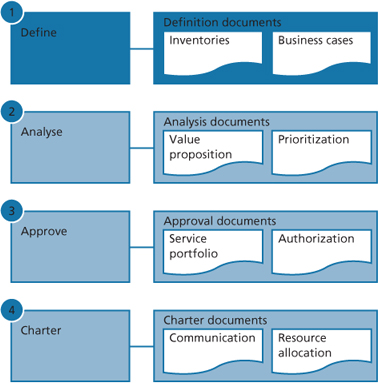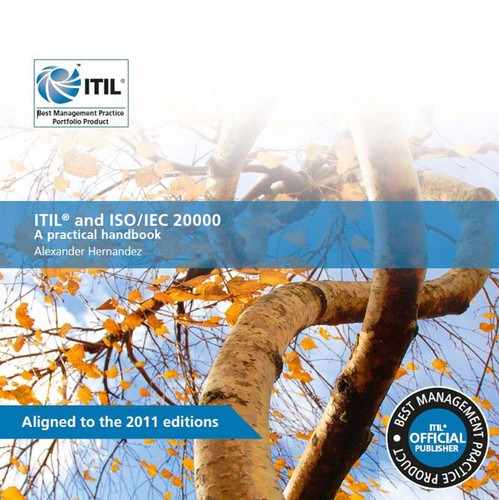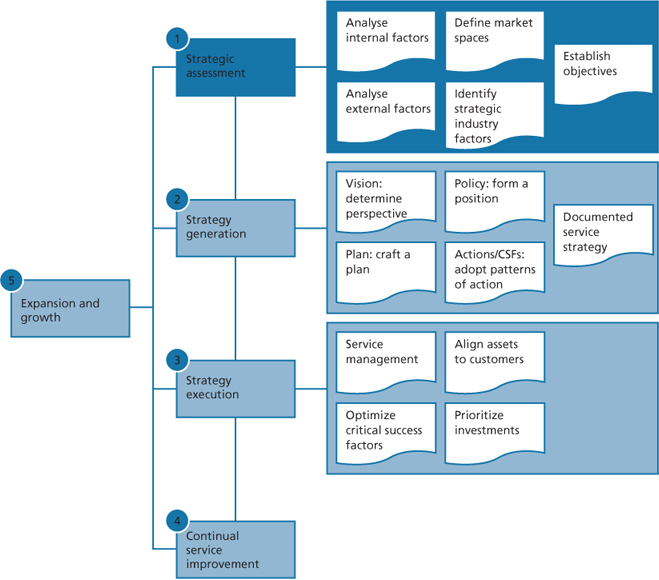3.1WHERE DO WE WANT TO BE?
The continual service improvement (CSI) approach presented by ITIL is a pragmatic way to assist an organization in understanding its future reality (see Figure 0.1).
The organization will first want to use the ITIL service strategy practices to help it to understand where it wants to be. The strategy management for IT services process within ITIL Service Strategy assists an organization to define and maintain its position, plan, patterns and perspective as related to its services and their management. Strategy management for IT services is also responsible for ensuring that the organization can achieve the intended business outcomes once a strategy is defined. The service portfolio management process integrates closely with strategy management for IT services by describing the provider’s services in terms of business value and articulated business needs, along with the provider’s response to those needs.
Figure 3.1 illustrates the strategy management for IT services process. Step 1, in particular, will help an organization to understand what its vision is and where it wants to be.
- Strategic assessment The organization needs to assess how it can best support the business objectives by analysing:
- Strengths, weaknesses, opportunities and threats (SWOT)
- Internal factors
- External factors
- What market spaces are interested in services?
- What types of services can it provide or does it need to define?
- Does it have any in-depth knowledge within a specific industry, such as healthcare or finance?
- Are there strategic industry factors that need to be considered?
- What are the organization’s core objectives?
(Cost recovery, profit centre etc.)
- Strategy generation Input is taken from the strategic assessment to assist in generating a strategy. Factors to consider include:
- What are the key differentiators?
- What is the long-term vision?
- What is the plan of execution?
- What is the policy that will be established to support your identified position in the marketplace?
- What actions will be taken to execute the strategy and what are the critical success factors (CSFs) for successful execution of the documented strategy?
Figure 3.1 Strategy management for IT services
- Strategy execution This is where the documented strategy is executed to achieve alignment between service assets, service processes and services provided. The priority of execution of services is determined so that the organization remains competitive. More importantly, knowing which core services must be delivered to provide a distinctive competitive advantage needs to be part of strategy execution.
- Continual service improvement Measure through ‘Plan–Do–Check–Act’ to identify where service optimizations and improvements can occur to allow the organization to continue to provide a competitive advantage.
- Expansion and growth Through identified improvement initiatives, the organization can further expand and grow its services based on changing business needs.
Figure 3.2 illustrates the service portfolio management process. Step 1, in particular, will assist an organization in understanding which services it needs to consider in the portfolio.

Figure 3.2 Service portfolio management
Service portfolio management describes the provider’s services in terms of business value and articulated business needs. There are four main steps:
- Define Define the service using a standard approach and template that is clear and understandable to the business. Take into account the current inventories of services and supporting business cases to understand which services will provide value to the business.
- Analyse Based on the current identified services from Step 1 and the generated supporting business cases, analysis is performed to determine the value proposition of the identified services. The analysis results are prioritized based on the value they bring to the organization, their cost and the effort needed to implement them.
- Approve Services are then authorized to proceed to the next stage (to be chartered), becoming operational services within the service catalogue. Also at this stage, it is determined which services are to be retired and modified to best provide value to the business.
- Charter When services are chartered, they become an integrated part of the service catalogue, operational and available for consumption by the business/customer. A charter is a document authorizing the project and stating its scope, terms and references.
Figure 3.3 illustrates the integration of strategy management for IT services and service portfolio management, demonstrating the critical importance of these processes to supporting the overall organization’s vision and governance structure.
An organization needs to have an end state in mind to answer the question ‘Where do we want to be?’ It is just like planning a move to a new country. You need to know the city and neighbourhood to which you will be relocating before actually moving. This requires the development of a roadmap and a set of key actions that need to be completed to make your move a success. The same holds for an organization: it must have a clear idea of its current business services and the underlying capabilities that support those business services. Knowing the ‘as is’ (current) state of its business services and capabilities will assist an organization to understand the gap between that state and the ‘to be’ (future) state. The organization also needs to understand how the service management processes enable and support the current business services and capabilities, and how they will support the ‘to be’ business services and capabilities.

Figure 3.3 Service management governance example
For example, if a large hotel chain provides a check-in service, there will be a mapped set of current business capabilities. Table 3.1 provides an example.
Table 3.1 Current business service and capabilities
Business service |
Current capabilities |
Check-in |
Manage check-in room reservations – internet browser only Manage upgrade room reservations – internet browser only Manage check-out room reservations – internet browser only Manage room changes – internet browser only |
Let us say that the organization wants to further enhance its check-in service by also making the service available as a mobile-phone or tablet application. Table 3.2 shows the updated check-in service and capabilities.
Table 3.2 Future business service and capabilities
Business service |
Future capabilities |
Check-in mobile-phone/tablet application |
Manage check-in room reservations Live concierge service Room service Shuttle pick-up Manage upgrade room reservations Manage check-out room reservations Manage room changes |
This example supports the two key ITIL service strategy processes – strategy management for IT services and service portfolio management.
3.1.1Strategy management for IT services
Within this process, Step 1 – strategic assessment (see Figure 3.1) assists in determining how IT can best support the business objectives after assessing current needs. The performance of a strategic assessment is a pivotal input for the hotel chain to understand its position in the hospitality industry. The hotel chain needs to consider the following questions when performing a strategic assessment:
- What internal strengths does the hotel chain have with regard to the execution of hospitality services and the internal mechanics that assist it to achieve operational excellence?
- What internal weaknesses does the hotel chain have that hinder it from further expanding its hospitality service to better serve the customer?
- What external opportunities exist that the hotel chain can capitalize on to expand its service line and enter new market segments?
- What external threats exist that could impact the increased growth of the hotel chain?
- What additional markets can be captured by expanding the hotel chain’s online presence, both on mobile platforms and on the Web?
- What additional services can be offered by expanding the hotel chain’s online presence, both on mobile platforms and on the Web?
- How can the hotel chain leverage its depth in providing hospitality services to enter into entirely new market segments that interface with the hospitality industry?
- Are there strategic industry factors that could impact on the hotel chain?
- What is the hotel chain’s core objective? (Cost recovery, profit centre etc.)
Below are more specific questions that support the check-in service capabilities presented in Table 3.1:
- What can the hotel chain do to increase the number of hotel bookings online?
- What types of service can the hotel chain provide or does it need to improve the user check-in experience?
3.1.2Service portfolio management
Within this process, Step 1 – define the service (see Figure 3.2) provides a standard approach and template that is clear and understandable to the business, taking into account the current inventory of services and supporting business cases. The hotel chain needs to consider the following questions:
- What current capabilities exist that support the business check-in service?
- What new business services need to be considered to further enhance the online user experience when making reservations at the hotel chain?
- What new capabilities need to be considered to support the new business services to enhance the online user experience when making reservations at the hotel chain?
A great resource that assists you in providing input to your supporting business cases is the exemplar implementation plan in ISO/IEC TR 20000-5:2010, Part 5 (see Table 3.3). These activities need to consider the context of the service provider’s business needs and business model.
Table 3.3 Basis for the implementation
3.1.3Plan new or changed services
In order to effectively implement new or enhanced business services and capabilities within the hotel chain, the service provider needs to place a strong focus on the service transition processes within the ITIL framework and also on clause 5.2 (design and transition of new or changed services) of ISO/IEC 20000-1:2011, Part 1.
Table 3.4 provides an example of the current state of the hotel chain’s service provider and also specifies the future state it would like to achieve for its targeted processes for service transition. As you can see, the service provider is interested in elevating its service transition processes to a managed and established maturity level. This will assist it in better introducing and managing enhanced or new business services and capability changes for the hotel chain, to support the online check-in business service.
Table 3.4 Current state and desired future state
Process areas |
Current state rating |
Desired future state rating |
Transition planning and support |
1 |
3 |
Change management |
0.5 |
3 |
Service asset and configuration management |
0 |
2 |
Release and deployment management |
0.5 |
3 |
Service validation and testing |
1 |
3 |
Change evaluation |
0 |
2 |
Knowledge management |
0.5 |
2 |
As input to planning for new and changed business services, the service provider shall take into consideration the potential financial, organizational and technical impact of delivering the new or changed services. The service provider shall take into consideration the potential impact of the new or changed services on the service management system (SMS).
Planning for the new or changed services shall contain or include a reference to at least the following:
- Authorities and responsibilities for design, development and transition activities
- Activities to be performed by the service provider and other parties, including activities across interfaces between the service provider and other parties
- Communication to interested parties
- Human, technical, informational and financial resources
- Timescales for planned activities
- Identification, assessment and management of risks
- Dependencies on other services
- Testing required for the new or changed services
- Service acceptance criteria
- Expected outcomes from delivering the new or changed services, expressed in measurable terms.
For services that are to be removed, the service provider shall plan for the removal of the service(s). Planning shall include the date(s) for the removal, archiving, disposal or transfer of data, documentation and service components. The service components can include infrastructure and applications with associated licences.
The service provider shall identify other parties who will contribute to the provision of service components for the new or changed services. The service provider shall evaluate their ability to fulfil the service requirements. The results of the evaluation shall be recorded and necessary actions taken.
3.1.4Design and development of new or changed services
According to Part 1, clause 5.3 of ISO/IEC 20000-1:2011, the new or changed services shall be designed and documented to include at least:
- Authorities and responsibilities for delivery of the new or changed services
- Activities to be performed by the service provider, customer and other parties for delivery of the new or changed services
- New or changed human resource requirements, including requirements for appropriate education, training, skills and experience
- Financial resource requirements for delivery of the new or changed services
- New or changed technology to support the delivery of the new or changed services
- New or changed plans and policies as required by Part 1 of ISO/IEC 20000
- New or changed contracts and other documented agreements to align with changes in service requirements
- Changes to the SMS
- New or changed service level agreements (SLAs)
- Updates to the service catalogue
- Procedures, measures and information to be used for the delivery of the new or changed services.
The service provider shall ensure that the design enables the new or changed services to fulfil the service requirements. The new or changed services shall be developed in accordance with the documented design.
3.1.5Transition of new or changed services
The new or changed services shall be tested to verify that they fulfil the service requirements and documented design, and verified against service acceptance criteria agreed in advance by the service provider and interested parties. If the service acceptance criteria are not met, the service provider and interested parties shall make a decision on necessary actions and deployment (ISO/IEC 20000-1:2011, Part 1, clause 5.4).
The release and deployment management process shall be used to deploy approved new or changed services into the live environment. Following the completion of the transition activities, the service provider shall report to interested parties on the outcomes achieved against the expected outcomes.

